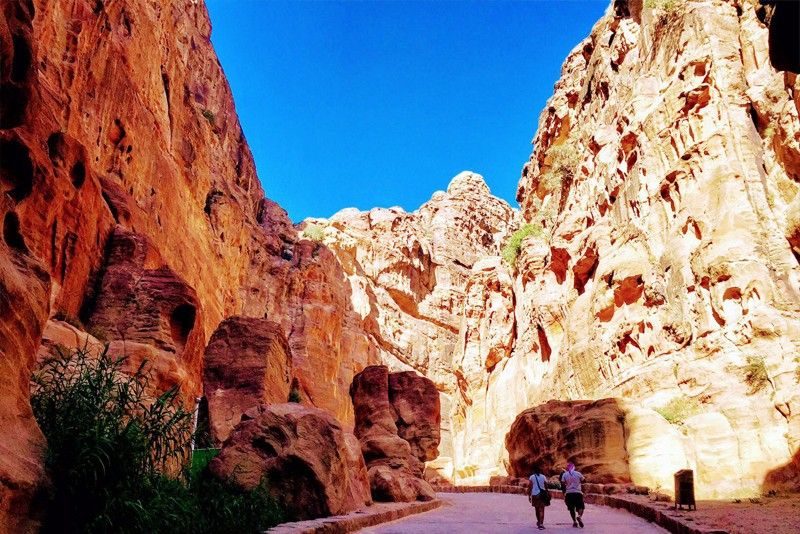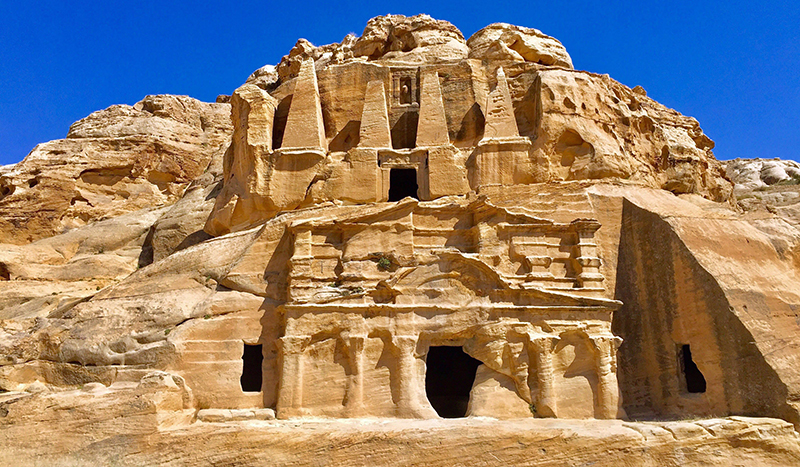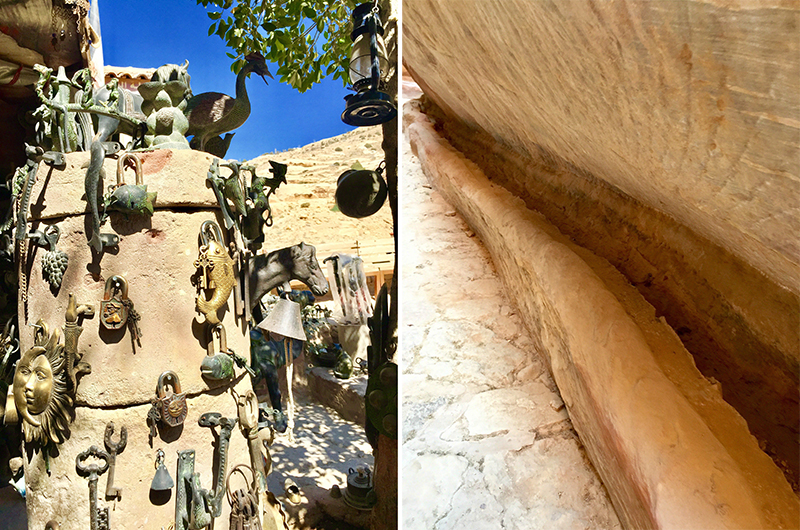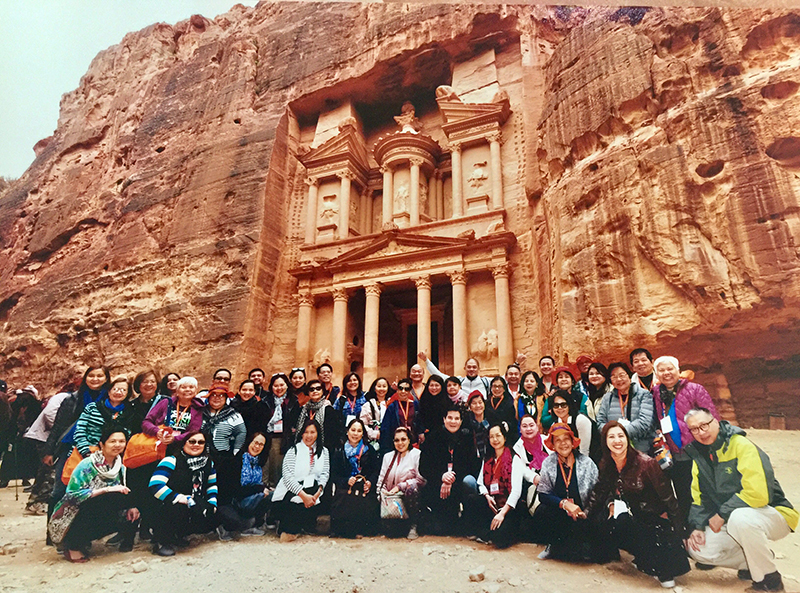Listen to the sound of Petra’s silence


Petra is a Unesco World Heritage Site since 1985. Photos by Carmina Orbe
A trip to Petra is an excursion to silent joy, an expedition to worship nature, a journey to fortify one’s faith in God.
Silence, without doubt, has a sound. In Petra, the city reverberates with solemn joy. Rose-colored rocks, muted by time 30 million years ago, echo the splendor and might of the ancient city, inviting the spectators to revere this expansive natural altar.
Petra is a historical and archeological city in south Jordan. Established as early as the 4th century BC, it was the capital of the Nabataean Kingdom. The city is famous for its rose-cut architecture and water conduit system. Another name for Petra is the Rose City due to the color of the stone out of which it was carved. It has been a UNESCO World Heritage Site since 1985.
The opportunity to be mesmerized by Petra happened when my dear friend Carmina Orbe (whom I met when we cruised the Nile River in Egypt last year) invited me to join a Jordan and Israel pilgrimage organized by the Catholic Travel, Inc. Our group was headed by the amiable and charismatic pilgrimage chaplain Fr. Dave Concepcion. There were about 50 of us, including award-winning actor Edu Manzano and the other friends I made during the pilgrimage like Arlene Santamaria, Bona Lirios, Joanne Angeles, Mercado family, Tita Magdalena Allayban, Debbie Calupitan, Donna Cruz, the Aruta family, the Eugenio family, the Palanca family, Valdemoro sisters, Marquez sisters, among others.

The giant Royal Tombs, gazing out over the hidden valley, is a sight to behold.
The trip that started in Manila to Amman to Mt. Nebo to Petra was a proof that friendships took place when people who did not know of each other before the trip shared a common passion for faith and wanderlust. This kind of friendship was celebrated when the group converged at Mt. Nebo where Moses viewed the Promise Land before he died.
There were many highlights of the trip but allow me to start with one of the most impressive and mind-boggling—Petra.
Petra’s expansive sandstone hedge over the dry valley of Wadi Musa resembles stacks of fire-hued clay. This arid desert showcases the 200-meter-high walls that keep the Siq permanently cast in shadow. The Siq is a mile-long narrow gorge that leads into the city of Petra. The silence at Petra is so arresting that seemingly no one can hear lone footsteps in the Siq’s shadow and stone.
Petra, whose prominence in my mind was first created after watching the 1989 movie Indiana Jones and the Last Crusade, was once a lost city. Until it was rediscovered by a Swiss explorer named Jean Louis Burckhardt who wrote in his diary in 1812 that the rediscovery of Petra “is one of the most elegant remains of antiquity existing.” Lonely Planet describes it vividly that when Burckhardt crossed Petra’s threshold, he was the first outsider to do so for 600 years — hidden by its natural fortifications, the city has remained obscure to the West since the time of the Crusades. In the past, it was the home of 30,000 people whose survival was desert landscape and was the center of a kingdom four times the size of modern Jordan.
According to archeologist Charles Otloff, the water supply and distribution system of the Nabataean city of Petra in southwestern Jordan has been explored and mapped. An old world like Petra reveals a modern water system. Analysis of the system indicates that ancient people of Petra had knowledge of sustainable use of water resources, replete with pipeline systems to maintain a constant supply of water through out the year.
Petra is one of the new Seven Wonders of the World and no one goes to this city without seeing the Treasury. To enter the Treasury, one needs to walk through the Siq canyon, a 200-meter-high wall of sheer rock. The peace that permeates at the Siq canyon is the celebration that explodes in the heart of the spectator. For one, the canyon is forever cast in long shadows of rock.

Antique finds at Three Kings Store beside the Siq(left). Petra is aslo known for its ancient water system(right).
What makes the Treasury fascinating is its iconic façade, which details its columns and exquisite carvings directly done from the face of the cliff. Visitors to Petra look forward to be awed by the sight of the Treasury after a 1.5-kilometer walk on the Siq to see the most magnificent of Petra’s sight.
According to our tour guide, the Treasury was probably constructed in the 1st century BC. As its design has no precedent in Petra, it is thought that it was carved by Near-Eastern Hellenistic architects.
There is mystery that shrouds the Treasury, believed to hide ancient treasures of the pharaohs. In an attempt to release the treasure, the Bedouins periodically fired guns at it with the bullet holes are still clearly visible on the urn.
Our guide Omar Karborani said that when the first Western visitors arrived in Petra in the 19th century, a stream ran from the Siq and across the plaza. The stream has since been diverted and the plaza leveled for the sake of tourists.
What did we see in the Treasury? There are two levels in the Treasury, decorated with columns, classical rooflines and severely weathered sculptures. Nestled on top of the façade is an eagle, a Nabataean (and Greek) male deity symbol. Tholos may be the fertility goddess of Petra, El-Uzza (associated to the Egyptian goddess Isis) looms as the central figure on the upper level Tholos. The vertical footholds on either side may have been made to aid the sculptors.
Far away from the Treasury is another magnificent find. Walk along a street serenaded by a series of columns to Petra’s largest monument and the path will lead you to the Monastery, carved from a mountain summit. Like the Treasury, the Monastery is also an inaccurate sobriquet. Online sources said that it was named Monastery perhaps because it’s located far away from the center. And there are crosses inscribed in the interior, making it appear like a place of worship. Although it was more likely used as a temple.

No one visits Petra without posing before the Treasury: (front) the author Christine Dayrit, Milette Marquez, Rina Palanca, Jojo Rafer, Yoly Palanca, Justice Zeny Laguiles, Edu Manzano, Tes Mercado, Kim Aumentado, Ading Allayban, Joan Angeles, Fr. Dave Concepcion; (second row) Carmina Orbe, Tess Marquez, Bona Lirios, Pepang Servino, Nanette Basilio, Meliss Bernabe, Joey Palanca, Baby Palanca, Debbie Calupitan, Donna Cruz, Mary Tamayo, Arlene Santamaria, Fe Schlegel, Baby Mercado, Avic Tan, Randy Aruta, Justice Lily Eugenio, Kristine Bañez, Teta Eugenio, Inday Salazar, Tess Valdemoro; (third row) Ghee Panganiban, Dante Bernabe, Jayvi Aruta, Cor Cor Nodini, Jun Palanca, Madz Ong, Philip Gabay, Vito Aruta, Bong Aumentado, Justice Tony Eugenio and Merson Mercado.
The Monastery has a similar design as that of the Treasury but it is bigger in size and less decorated. They say that getting to the Monastery is not for the faint-hearted because the trek requires more than an hour’s climb northwest of the city center on an ancient path of about 800 steps. The Monastery is also known as al-Deir or ad-Dayr in Arabic.
The other places to see are the massive Theatre and the giant Royal Tombs, gazing out over the hidden valley that shelters Petra’s city center. The High Place of Sacrifice offers spectacular views from a mountain-top altar, easily reached by a stepped path. Walking in an outlying wadi – Wadi Turkmaniyyeh is a prime example — takes you out of the tourist hubbub into still landscapes of barren peaks and wild canyons, while “Little Petra,” a few kilometers to the north, hides a mini-Siq and carved facades of its own, far from the main site.
You will never find a single mention of Petra in the Bible because its Hebrew name is Sela. Sela, like Petra, means “rock.” Sela is mentioned in Isaiah 16:1 and 2 Kings 14:7. Both Petra and Sela are appropriate names, since much of the city is carved into sandstone cliffs. Petra is located about 50 miles south of the Dead Sea and 170 miles southwest of modern Amman, Jordan. Ascending further into the hills, we came across what must be one of the last tombs still used as a Bedouin family home. Small but ornate, its dark entrance-way is guarded by a solid door, and there’s a garden of plants and fruit trees.
A trip to Petra is an excursion to silent joy, an expedition to worship nature, a journey to fortify one’s faith in God.
The ancient city will always remain in our hearts and minds. Petra, in its silence, is mind-blowing. Listen to the sound of Petra’s silence.
* * *
E-mail me at miladay.star@gmail.com. For more information on Petra, please call Catholic Travel, Inc. at 523-2523 or 0918-9110748 or log on to www.catholictravel.com.ph.



















